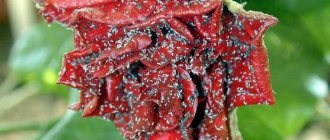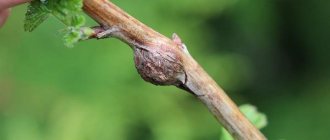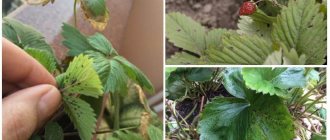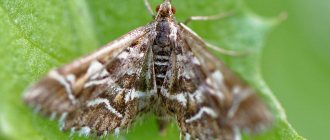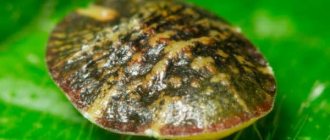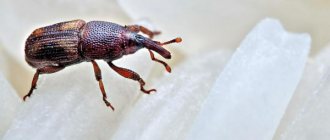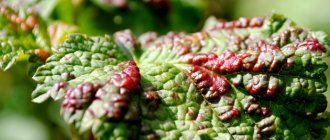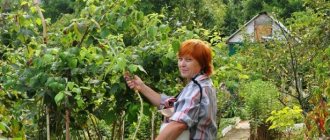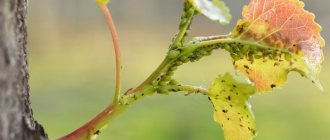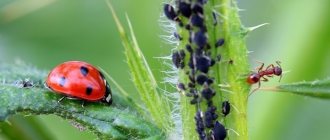Morphology
Imago . Beetle 2–3 mm long. The body shape is oval, widening beyond the middle. [2] Like all representatives of the genus Anthonomus, the head has moderately convex eyes, but protruding beyond its contours; antennal flagellum seven-segmented; pronotum transverse; the elytra widen behind the middle, with well-developed humeral tubercles located at the base; hips with a simple tooth. [1] The color of the integument of the raspberry-strawberry weevil is black, occasionally with a brown tint, the body is densely covered with gray hairs. The rostrum is long, thin, slightly curved. The shield is white. The legs are long and thin. [2] The lower legs are thin, straight on the inside. [9] The punctures on the pronotum are very dense and small. The antennae are geniculate and club-shaped. [4]
The egg is round, yellowish-white in color. Size – 0.35–0.5 mm. [2]
The larva is sickle-shaped, white, with a brown head. [2] Reaches 5 mm in length. Legless, with sparse hairs. [4]
The pupa is yellowish-brown in color. Size – 2.5–3 mm. [2] At the beginning of development it is white. [4]
Phenology of development (in days)
Development
Imago . Immature beetles leave their wintering grounds around the end of April - beginning of May, when the average daily air temperature is not lower than +13°C. At this time, they feed on strawberry leaves and other plants from the Rosaceae family, which resume growth early. Later, the pests move to blackberries, raspberries, and rose hips. First, the beetles make holes in the leaves and damage the petioles, then they switch to feeding on the buds, gnawing out their contents. Nutrition lasts 1–1.5 months. The greatest concentration of beetles on food plants is observed at temperatures of 18–20°C. [2]
Mating period . When they reach sexual maturity, the beetles begin to mate. Egg laying begins in mid-May and lasts about 20–35 days. First, the beetles lay eggs in the buds of garden and forest strawberries, and after the formation of buds on blackberries and raspberries, they fly to them. Females lay eggs in a hole gnawed in the side of the bud, cover it with excrement and gnaw the peduncle. One egg is laid in each bud. Fertility – up to 50 eggs. [2]
Egg . After 2–8 days, the damaged buds fall off. The embryo develops inside them for 7 days. [2]
The larva feeds on the contents of the buds. If this part of the plant does not fall to the ground, the larva dies. Development occurs in about 20 days. [4]
The pupa develops in 7–9 days, also inside the bud. [2]
Imago : Young beetles appear in the second half of July, feeding, as in spring, on the leaves of strawberries, raspberries and on the ovaries of late varieties of strawberries. When the temperature drops to 10–12°C, they go into winter dormancy in the top layer of soil or litter. [2]
Related species
Anthonomus pomorum L.
Description of the pest
Appearance
The raspberry-strawberry weevil is a 2-3 cm long beetle that has an oval body and a long thin rostrum with geniculate antennae. Weevil eggs, the size of which is half a millimeter, are white and round in shape. The weevil larva is grayish-white in color, about 3.5 mm long, has a curved body, and has no legs. The weevil pupa, 3 mm in size, is initially white in color, which later changes to brown.
Life cycle
Immature beetles overwinter in leaves on the surface of the ground or in the top layer of soil. In the spring, when the ambient temperature rises to +13 ºС, overwintered beetles climb to the surface of the earth, onto strawberry plantations. For their feeding, the beetles first use the growing leaves, gnawing small holes in them.
The number of beetles continuously increases and reaches a maximum by the time buds begin to form on the strawberry bushes. When the buds appear, the beetles begin to feed on the anthers , which are taken out of the buds after they are pierced.
At the same time, mating of weevils occurs. After mating, the female weevil gnaws at the side of a strawberry bud and lays an egg in the bud. She seals the hole in the bud with her excrement. Next, she gnaws the peduncle of the bud, which after a while dries out and falls to the ground.
Each female weevil can lay up to 50 eggs.
This masonry can last a whole month. Since the budding time of strawberries is limited and the female cannot lay all the eggs during this period, the female switches from early varieties to late varieties, and then to raspberries.
Further development of the weevil occurs inside the bud. A week later, a larva emerges from the egg. For 2-3 weeks it feeds and develops inside the bud. At the same time, the larva can be found on strawberries from mid to late May, and on raspberries - from early June to late July. The larva then pupates and turns into a pupa. The appearance of weevil pupae usually coincides with the ripening of strawberries and raspberries.
After the pupae develop for 3 weeks, beetles emerge from them inside the bud, which, after feeding on leaves and green berries for two weeks, go to winter.
Maliciousness
The raspberry-strawberry weevil feeds on raspberries, rose hips, blackberries, and strawberries. Adults and larvae are harmful. Additional feeding of leaves by imagoes does not have much effect on host plants. The pest causes maximum damage to plants by destroying the flower buds of food plants during oviposition, which occurs during the period from the budding of strawberries to the appearance of ovaries on raspberries. The proximity of strawberry and raspberry plantations gives females the opportunity to lay the entire supply of available eggs and leads to outbreaks of mass reproduction of the pest. [4]
Meet the garden pest
The raspberry-strawberry weevil lives everywhere where strawberries and raspberries grow. The agricultural pest is black in color. Its small oval body, reaching a length of 2-3 mm, is covered with small gray bristles. The small head is elongated into a long proboscis and is equipped with club-shaped antennae consisting of seven segments. The hard elytra have faint grooves.
Experienced gardeners and novice hobbyists are interested in the question of which order the strawberry weevil belongs to. The pest belongs to the order of Coleoptera beetles from the weevil family. Immature insects overwinter in last year's plant remains, under fallen leaves and in other secluded places. With the onset of spring, when the soil warms up to approximately 13°C, they begin to leave their wintering grounds. Determining what the raspberry pest feeds on is not difficult. At this time, strawberries begin to grow, which is the favorite food of beetles. They gnaw right through the young shoots of the crop, and when the first buds appear, they damage them and feed on unripe anthers.
Strawberry weevil
Timing and methods of processing strawberries
The insect is active from mid-spring, when the ambient temperature begins to exceed +10 °C - the female weevil has a favorable time for laying eggs. In summer, bushes can also become targets for beetle attacks. The seasonal activity of insects affects the control measures taken.
Spring
After winter, you should get rid of dried plants. The soil must be loosened, nitrogen fertilizers applied, and a thin layer of mulch applied.
Folk remedies for spring treatment
The arsenal of useful folk remedies includes:
- Garlic tincture, prepared by pouring 100 g of dry garlic arrows into a bucket of water (8 l). After 24-48 hours, filter the solution and irrigate the bed using a spray bottle at the rate of 1 liter of solution per 1 square meter. A week later the procedure is repeated.
- Ash. The solution is prepared at the rate of 1 glass of ash per 1 bucket of warm water (8 l). Usually several KMnO4 crystals are added to the solution. 1 liter of product is spent per 1 square meter. Spray the green part of the plant.
- Ammonia (aqueous ammonia solution). Ammonia has a pungent odor that repels insects. Half a tablespoon of alcohol is diluted in a liter of water. 1 liter of product is enough to treat 1-1.5 square meters. m. of land. Water using a regular watering can.
- A mustard-based solution has a repellent effect. To prepare it, 100 g of dry mustard powder is dissolved in 3 liters of water. The green mass is treated with a spray bottle.
- Soap solution. Forms a thin protective film on stems and leaves. To prepare the solution, 100 g of laundry soap shavings are dissolved in a bucket of warm water. Spraying is carried out three times at intervals of a week. Sometimes, in order to enhance the effect, 30 drops of an alcohol solution of iodine are added to the prepared product.
- Onion peel and celandine. To prepare the product, the original dried components are crushed in a ratio of 2/1 and the pan is filled to 33% of the volume used. The plant mass is poured with boiling water. After filtering, the product is applied from a spray bottle to the green mass of plants. To enhance the effect, it is recommended to repeat the procedure after 2-3 weeks.
- Infusions of tobacco, garlic (use 200 g of dry mass per 10 liters of water) or hot pepper (500 g per 10 liters). It is recommended to use it for treating plants during the formation of buds.
- Baking soda solution at the rate of 2 tablespoons per 10 liters of water (for watering).
- Decoction of tansy flowers. Prepared by soaking 300-400 g of dried flowers, or 1.5-2 kg of fresh flowers in 5 liters of water. Leave for 48 hours. Then the solution is boiled and 50 g of laundry soap shavings are added, after which the volume is adjusted to 10 liters with water.
- Product based on fir oil. To prepare, mix 2 tablespoons of green soap, fir oil and 10 liters of water. The resulting solution is used to treat the green mass of the plant.
Mechanical methods
Used when insect pests attack fruit-bearing bushes.
Manual collection of pests on strawberries involves three simple steps:
- Spreading sheets of newspaper around the plant.
- Shaking the bush in the morning.
- Rolling up newspaper sheets and then burning them along with fallen insects.
You can use a saucer trap filled with sweet syrup. If you place such a container next to a strawberry bush, the next morning some of the insects will swim in it.
In the spring, before shoots appear, effective methods of combating the weevil are digging up the soil, collecting infected buds by hand, as well as watering with hot water (+60...+65 ° C), which is considered safe for the plant, since the roots of the strawberry are not affected. .
Chemicals in spring and during fruiting
Please note that chemicals with a strong odor may repel bees that pollinate plants. Therefore, the choice of chemical means of protection should be selective.
Approximately 28 days before harvesting the fruits, pesticides should be discarded so that the ripening berries do not absorb them.
Weather conditions should also be taken into account. Treatment should be carried out only in dry, windless weather. Rain or strong winds have a negative impact on the treatment - the chemicals are washed off or blown away.
Chemicals are used in cases where other methods of protection against insects are ineffective. The biological agents Fitoverm and Iskra have proven themselves to be effective and can protect plants for several weeks. Recommended for use in spring and autumn.
Insecticides (Karbafos, Intavir (Inta-vir), Metaphos) are not only capable of saving cultivated plantations from insect pests, but also cause significant harm to human health. In this regard, they should be used only as a last resort, carefully observing safety precautions. To avoid poisoning, it is necessary to use personal protective equipment for the skin and respiratory system. Usually, before spraying, 10 ml of insecticide is diluted in 10 liters of water.
Autumn
In the autumn, suspicious plants with thickened stems and deformed leaves are disposed of. The remaining bushes are treated with broad-spectrum insecticides.
Reproduction
Approximately a month after active saturation, strawberry weevils, having reached sexual maturity, begin the mating process. The female begins to lay eggs from mid-May, and this period lasts for a month.
Initially, the beetles lay eggs on flowering strawberries. The weevil pierces the side of the bud and lays one egg in it. Then it seals the hole with excrement and prudently gnaws the peduncle. After a few days, the buds turn brown and fall off. The embryo inside develops within seven days. Due to the short budding period of strawberries, the flower beetle weevil moves to later varieties, and then to raspberries, blackberries and strawberries.
When to spray strawberries against weevils
With the onset of spring, as soon as the sun warms up, weevils begin to crawl out and find strawberries. And the worst thing is not the eating of leaves and stems, but the fact that they lay eggs in the buds.
A few days after the eggs are laid, larvae appear and destroy the flower.
So how can you treat strawberries?
Insecticides that have proven themselves to be effective:
- intavir
- inta
- Gordon
- corsair
These preparations can be purchased at a gardening and hardware store.
New drugs have also appeared:
- fitoverm
- spark - bio
- akarin
- nemabact
These drugs can be used in spring and autumn.
Strawberries are treated against weevils twice. It is necessary to spray no later than five days after the start of flowering and harvesting of strawberries. It is better to do this early in the morning.
All medications must be used strictly according to the instructions.
Spring
Spraying in spring is carried out in March - April as soon as the snow melts. You can treat with Fitosporin, copper sulfate, Bordeaux mixture, Trichodermin.
Mostly in the spring they clean up dried leaves and plants. After harvesting, each strawberry bush is loosened and fertilized. Apply nitrogen fertilizers and mulch the bushes with humus.
In spring, all dry leaves, plants, and last year's mulch must be burned.
The weevil does not tolerate the smell of garlic and onions; plant these crops in the strawberry bed.
In spring, sprinkle ashes around each strawberry bush.
Autumn
In the fall, you need to carefully inspect all the bushes, dig up the affected bushes and burn them. If the strawberry bed is severely affected, it is better to completely eliminate it and spill it with a solution of iron sulfate.
You can plant calendula or marigolds in an empty space.
The timing of spraying depends on the strawberry variety; regular strawberries are sprayed in September, and remontant ones are sprayed before winter.
More often for spraying strawberries in the fall they use:
Fitoverm
Spark - bio
If, upon inspection, you notice holes on the strawberry leaves, this means the weevil is starting to drink juices before wintering. Then you should hurry up with spraying. Use the medications according to the instructions.
Signs of a harmful beetle in the garden
The main symptoms indicating the presence of weevils on berry crops include the following characteristic phenomena:
- small diameter holes or punctures on early strawberry foliage;
- browned berry buds;
- a large number of fallen, as if cut, inflorescences;
- on the bushes you can see overcrowded buds hanging on a dried stem.
The presence of at least one of these phenomena indicates that the strawberry weevil has settled in the garden plot
Protective and preventive measures against beetles
To save plantings of strawberries, raspberries and other berry crops from the voracious beetle, care should be taken to create conditions on the site that are unfavorable for its existence. Experienced gardeners recommend taking the following precautions:
- regularly dig up the rows to destroy beetles hiding for the winter;
- avoid dense, unkempt areas;
- renew raspberry and strawberry plantings by removing old plantings;
- periodically inspect the plantings and shake off crawling raspberry weevils until the end of the harvest;
- if possible, plant early varieties of strawberries and strawberries;
- the raspberry weevil does not tolerate the pungent odors of Chernobrivtsev, lilies of the valley, nasturtiums and garlic, so they can be planted next to the berry garden;
Plants from strawberry weevil
- remove and burn all garden waste in spring and autumn;
- destroy damaged shoots and leaves;
- try to attract the natural enemies of the weevil, ground beetles, into the garden, which are capable of destroying up to twenty-five beetles each per day.
These and other preventive control measures will reduce the risk of garden plot infestation with dangerous agricultural raspberry pests.
Damage caused by the raspberry-strawberry weevil
These pests cause damage to raspberry and strawberry plantations. The damage is mainly caused by larvae, since adult weevils feed on leaves, and their feeding does not last long. But females destroy the buds during oviposition.
Enormous damage is caused to early varieties of strawberries, since pests spoil their first buds, from which the largest berries should have ripened. In late strawberry varieties, weevils destroy second- and third-order buds, which are not so important.
Raspberry and strawberry weevils are capable of destroying entire berry plantations.
If a plant has a hard type of flower, then it suffers to a lesser extent, since its stamens are underdeveloped, so they contain fewer nutrients. Raspberry and strawberry weevils cause the most significant damage to older plantations.
You can understand that a plantation is infected with the raspberry-strawberry weevil by the following signs: punctures and small holes on strawberry leaves in spring, shedding of buds and the presence of a larva inside the fallen bud.
If you find an error, please select a piece of text and press Ctrl+Enter.
Radical means of combating weevils
If all preventive measures have not brought the expected result and the beetle continues to dominate the garden, then you should move on to more effective means of exterminating the pest. The fight against strawberry weevil involves the use of chemicals or safe folk remedies. To get the maximum effect, you need to know at what time to treat plants. The fight against the beetle must begin when the pedicels have already formed and risen, but the buds have not yet separated. At this time, the greatest concentration of insects is observed on berry crops, and they are available for a wide variety of drugs.
People's recommendations
The raspberry weevil can be destroyed using solutions prepared using means available to everyone. The following recipes have worked well:
The given recipes make up a small part of the means that gardeners use to kill beetles.
Chemicals
How to fight weevils using insecticides is described in detail in the instructions for each product. Manufacturers recommend using a large number of different preparations to treat berry crops. The following will help protect raspberry bushes from weevils and preserve the harvest:
The most commonly used for spraying strawberries is:
Knowing where the strawberry weevil lives, it is necessary to carefully process all plantations of berry crops in accordance with the recommendations set out in the instructions.
Fighting methods
Having extremely strong teeth, the beetle easily copes with plastic and paper bags and makes its way to the food it is interested in: flour and cereals. Having discovered a weevil, you need to act urgently to get rid of it. It is difficult, but quite doable, but prevention should start. There are many different ways:
- It is necessary to check your food supplies from time to time: pasta, cereals, dried fruits, flour, as well as coffee, cocoa and tea for the presence of pests. And throw them away immediately, as they are dangerous to eat.
- To get rid of weevils, grain products must be stored in the refrigerator, where at a temperature of 0 degrees, adult beetles die after 63 days, larvae after 30 days, and eggs after 19 days.
- High temperature (35 degrees and above) is a good way to get rid of a household pest.
Popular Measures to combat gall aphids on currants
How to deal with weevil and how to get rid of it?
- Work inventory should be reviewed frequently.
- Remember that the weevil is a pest that does not like noise and does not stay in such places.
- These are heat-loving individuals and if the temperature drops below 5 degrees, they freeze. At a temperature of minus 5 degrees, after a month all eggs, larvae and adults die. It can also be frozen at minus 15 degrees for at least 24 hours.
- An effective method is calcining products at a temperature of 55 - 60 degrees for at least 48 hours. At a temperature of 40 degrees, insects die within two days.
- Bay leaves and dried lavender flowers will also help you get rid of barn elephant. Place them on shelves or attach bags to the walls of kitchen cabinets. The smell will repel pests.
- Periodically wipe kitchen furniture with a soap solution and vinegar.
- Store food in tightly closed glass containers. In each of them put a peeled clove of garlic, the smell of which will scare away the elephant.
- Treat shelves and cabinet walls with pyrethrin, removing all food before doing so. Carefully read the instructions on the product packaging and only then put the products back on the shelves.
- Buy products as needed, it will be easier to get rid of the pest and take preventive measures.
Even if you have taken all measures to get rid of the pest, products where bugs have been noticed are not suitable for human consumption due to the appearance of bacteria and pathogenic fungi on them. Contaminated cereals and other products are suitable only as food for birds and farm animals.
Lavender sachet will repel weevils
Fighting on an industrial scale
We need to start with prevention. Disinfect the premises intended for grain storage, thoroughly dry the grain before storage, and clean the grain from other impurities.
Getting rid of the pest in large volumes of products is much more difficult, but here there are effective methods to remove the bug:
- Thermal treatment of products is used (disposal using temperature). Significantly increasing or decreasing the room temperature.
- Chemical method. Insecticides and the method of fumigation (treatment with gas or steam formed from a solid or liquid substance. At sufficient concentrations, it kills pests in the grain. Gas or steam easily penetrates the respiratory organs of insects, killing them.) and grain spraying are used. Usually the drug “Foxin” is used as a fumigant. Suitable for control and specifically designed for this purpose: Actellic 20 FU (gas candle), Strips 56 GE, available in the form of tablets or special strips, Deltox 56 GE, Quickphos Pellets 56 GE, Quickphos Tablets 56 GE, (insecticide in the form of tablets or gas strips ), Talisma EC Rovar 500 EC, K-Obiol 25 EC Actellic 500 EC (insecticide concentrate for spraying).
Chemicals must also be selected according to the type of facility and the type of grain stored there.
Strawberry weevil - features and measures to combat the pest
The strawberry weevil is a dangerous pest that can completely destroy a crop. It is also called raspberry-strawberry, since one type of parasite lives on these two plants, as well as on strawberries, blackberries and even rose bushes. It is dangerous both at the mature and larval stages - the beetles feed on leaves and young shoots, and then lay eggs in the buds, thereby causing irreparable damage to the crop. There are several ways to deal with weevils on strawberries, strawberries, raspberries and other plants - all you have to do is choose the most suitable one and start acting.
Raspberry beetle and raspberry weevil
On raspberry flowers you will always find two types of bugs: one black one with a proboscis - this is the raspberry weevil, or elephant weevil; the second is light brown, looking like a tiny cockchafer. Both of them damage the flowers, which is why the berries then become crooked or disappear altogether. When in danger, the bugs curl up their paws and fall down. These “beasts” are capable of destroying the entire raspberry crop. Sometimes there are so many of them on the bushes that even shaking them daily into a tray does not save the berries at all.
It is believed that beetles are driven away by infusions of elderberry, wormwood, etc. Frankly speaking, they are rather weak! The truth is that if the beetle was allowed to calmly get out of the soil in the spring, then it cannot be stopped so easily. The beetle must be dealt with while it is in the soil. Therefore, it is useful to first till the soil in the raspberry patch twice - in the fall and early in the spring, and then cover it with a thick layer of mulch. The beetle will, firstly, have its passages through which it intended to crawl out destroyed, and secondly, a dense layer will block its path. Film mulch is the most reliable.
When you come across a productive raspberry tree whose owners report that they don’t spray it with anything at all, then, of course, you begin to look for the reason for the suppression of beetles. It can be very different. Often such support is provided by a constant thick layer of mulch: our gardeners once remembered that “raspberries love garbage,” and some lay manure, some hay, some sawdust under the bushes for fertilizer.
And the main benefit of mulch is that it somehow disrupts the conditions for successful wintering of this pest. Apparently, the beetle survives well in dense clay soil, and loose mulch contains many insect predators that destroy it.
One day I came across an unforgettable raspberry garden: rows of bushes strewn with large, clean berries. The owners lived in it with a couple of chickens: they walked along the rows all day long, stirring up the garbage under the bushes with their claws, looking for food. Either the birds “trampled” the passages of the beetles, or pecked them off, but they apparently affected the safety of the crop.
Sometimes raspberries growing mixed with fruit trees have their advantages: due to the shade, many berries set late, when the wave of beetles has already subsided. It is the late berries that are often the purest.
Of course, mixed planting of raspberries with other plants can be beneficial. This issue has so far been little studied. According to my observations, raspberries growing mixed with red currant bushes produce annual harvests of berries; even if the beetle is present, for some reason it cannot unfold. At the same time, red currants bear fruit abundantly.
Strawberry weevil - how to recognize
The pest belongs to the class of insects, order Coleoptera, family of weevils.
This is a black beetle, only 2-3 mm in length, with an oval body covered with light hairs. Strawberry weevils become active in mid-spring, when the temperature reaches 13-15° C. They feed on young shoots of strawberries and strawberries, and then move on to later plants - blackberries, raspberries and others. They damage the leaves and drink their juices, completely chewing off the internal parts of the buds. Adult beetles lay larvae inside the buds, 1 in each. Females gnaw the stalks so that the buds fall to the ground. Otherwise, the larvae cannot develop. Their development lasts about 20 days, then within 7-9 days the formation of pupae occurs, also in the middle of the buds. The beetles emerge at the end of July and feed on the shoots of strawberries, raspberries and other cultivated plants. When the temperature drops to 10° C, they go to winter in the top layer of soil or in the litter. The next year the cycle of their development repeats.
Beetles cause maximum harm by damaging plant buds - this leads not only to crop loss, but also to the death of plants. For this reason, weevil control on strawberries, wild strawberries and raspberries is carried out in early spring, before the ovaries appear.
Folk remedies for weevil on strawberries
The methods have been tested for years and are safe for health.
The disadvantages of folk remedies are that they require more time and effort. They last until the rains start, they wash away all your hard work.
Mustard solution
One hundred grams of dry mustard is first diluted in a liter of water, then another two liters are added. The prepared solution is sprayed onto strawberries.
Garlic tincture
100 gr. Add dried garlic leaves to a bucket of water and leave for 24 hours. Treat plants with the prepared solution at the rate of one liter per square meter.
To repel weevils, garlic bulbs are sown on strawberries. Garlic is said to repel pests. If, of course, the weevil itself knows that it should be afraid of garlic, then this may be so. Bulbs are sown more to rejuvenate their garlic varieties - if it is planted with cloves from year to year, it degenerates. But I know for sure that the weevil cannot stand flowering elderberry branches or resinous spruce chips if they are spread over strawberries.
Wood ash
Wood ash is poured in a thick layer under each strawberry bush. An excellent insect repellent.
Infusion of onion peel and celandine
Pour two parts of onion peel and one part of celandine with hot water for a day. Then strain the solution and spray the strawberries.
Ammonia
Dilute 30 ml of ammonia in a bucket of water and treat the strawberries with the resulting solution.
Tobacco and tobacco dust
To drive weevils out of strawberries, you need to sprinkle tobacco dust on the rosettes.
Another good remedy is tobacco solution. To prepare it, pour 150 - 200 g of tobacco dust into a container, add 10 liters of hot water and leave for 24 hours.
Soap solution
To prepare the solution, you need to grate 100 grams. laundry soap. Add soap to a bucket of hot water and stir. Allow the solution to cool, then begin processing.
Before flowering, strawberries are also sprayed with the following solution: 200 g of laundry soap is diluted in 10 liters of water. The procedure can be repeated after 10-12 days.
Birch tar
You can treat the bushes with a tar solution. It is prepared at the rate of 2 tbsp. l. and 30 gr. laundry soap per 10 liters of water. Usually the procedure is repeated after a week.
Iodine
For 10 liters of water you will need 0.5 teaspoon of iodine. To make the solution stick better, you can add 1 tbsp of liquid soap.
Weevils on strawberries in the spring can be destroyed with an iodine solution. 0.5 teaspoon of this substance is stirred in 10 liters of water. The resulting liquid is sprayed onto the plants. At the beginning of autumn, you can repeat the procedure.
Dentifrice
Ordinary tooth powder, lightly sprinkled over the beds several times a season, can also force the weevil to leave your beds. Tooth powder is sprinkled on strawberry rosettes in the spring and after flowering.
Potassium permangantsovka
Potassium permanganate 5g. dilute in a bucket of water. Leave for two days. Treat strawberries with the prepared solution.
Soda
A solution of baking soda is prepared at the rate of 2 tbsp. l. on a bucket of water. Can be used during flowering and fruiting.
Vinegar
Spray the plants with 9% vinegar diluted in a bucket of water in a ratio of 100 ml per 10 liters. The fact is that vinegar gives off a pungent odor that simply scares away the beetles, and they leave the plantation.
Nettle infusion
This folk remedy promotes both intensive plant growth and protects against harmful insects. To prepare, young nettles are crushed and the container is filled halfway. Then fill with water, without bringing it to the edges. The nettle infusion will be ready in two weeks. Use in a ratio of 1/10 (tincture/water).
Boric acid
Spraying boric acid on areas that have been infested with weevils is an effective home remedy.
Boric acid is less toxic to humans and has a wide range of industrial uses, but it also kills many insects, including cockroaches and weevils.
Acid negatively affects the egg production of weevils and disrupts their reproductive cycle. Simply spray boric acid on surfaces where weevils crawl.
Hand collecting insects
Place newspaper or paper under each strawberry bush. And early in the morning, shake the bugs off the plant. The litter with fallen insects must be burned.
Mechanical methods
Dry leaves and debris are removed from strawberry beds. The soil around the strawberries is loosened.
In spring, the beds are watered with hot water. Damaged ovaries and buds are removed and burned.
Control measures
If weevils appear on the site, you need to get rid of them urgently. One female can lay up to 50 eggs per season, which turn into adults in the second half of summer. Weevil control in spring, summer and autumn includes mechanical and chemical methods. You can also use simple folk remedies.
Mechanical methods
The first rule on how to preserve the harvest is not to plant strawberries and raspberries in neighboring beds.
It is better to place these crops at different ends of the plot, and also to choose varieties of strawberries and wild strawberries with the shortest flowering period. Other mechanical pest control measures include:
- manual collection and destruction of beetles;
- collection of fallen buds and subsequent destruction - they may contain larvae;
- autumn digging of soil under bushes;
- collecting fallen leaves after harvest.
An effective way to control weevils is with traps. You can prepare them yourself using available ingredients. For 500 ml of water, take 50 g of yeast and 100 g of sugar, leave the mixture in a warm room until the first signs of fermentation appear. Next, the solution is poured into containers with a narrow neck - once the beetles fall into the trap, they will no longer be able to get out of it.
Chemical methods
To kill pests, there are special preparations on sale - insecticides.
Modern products are developed taking into account the type of plants and parasites, have minimal impact on the quality of the crop and are suitable for home use. Treatments should be carried out 7-10 days before the start of strawberry flowering, when the first buds begin to appear. This way, the components of the products will not damage the flowers or jeopardize the future harvest. When working with chemicals, you should follow safety rules, wear protective suits, gloves and face masks. Strawberries can be treated against weevils in spring and summer with the following preparations:
- Karbafos, Metafos are simple and affordable options, but they act for a short time and destroy insects only when they come into direct contact with them;
- Inta-Vir is a broad-spectrum drug that poisons beetles and blocks their nervous system;
- Nemabakt (analogs - Fitoverm, Akarin) is a biological protection agent containing a nematode that destroys insects, and is applied routinely to the soil at any time of the warm season.
If strawberry weevils appear during the flowering period of plants, it is better to collect them by hand. Using insecticides can harm the bees that pollinate flowers.
Traditional methods
Folk remedies for weevils on strawberries, strawberries and raspberries are safer than store-bought insecticides.
They can be prepared from simple ingredients that can always be found on the farm.
- The simplest method is to plant beds of garlic and onions around the berry bushes. The smell of these plants will repel weevils.
- Wood ash is not only a valuable fertilizer, but also a popular insecticide. It can be scattered around bushes or beds, and also diluted in water for irrigation.
- An infusion of tansy and calendula also repels pests. It is sprayed on the leaves and buds of plants, and also applied to the soil. Fern grass has a similar effect, so it can be placed around the bushes.
- Garlic infusion is one of the most popular ways to combat pest beetles. 100 g of garlic pulp is infused in 10 liters of water for a week. Then the plants are sprayed with it. You can add 2 tablespoons of boric acid to the mixture.
- Regular potassium permanganate is also used in the garden. It is enough to dilute 5 g of dry raw materials in a full bucket of water. Distribute over the soil surface, leaves and buds. Instead of potassium permanganate, you can take 300 g of ground hot pepper.
The strawberry weevil is common in temperate climates. If it appears on the site, it will quickly continue to multiply, destroying cultivated plants. If you intervene in time, you can forget about the beetles and get a high-quality harvest.
Protecting strawberries from weevils - video
Strawberry-raspberry weevil. Control measures
I bought wonderful strawberry varieties Torpeda and Darenka from the nursery. All spring I admired the abundant blooms, and now only one tenth of the flowers remain. The pedicels of the remaining flowers are bitten, hang and dry out. During the budding period I sprayed it twice with Fufanon. I was calm that I protected the strawberry plants from all pests in time. But it turned out that this was not the case. Tell us in more detail about this strawberry pest and measures to combat it. V.A. Belyaeva, Artemovsky
This letter is about the strawberry-raspberry weevil, which damages the flowers of not only strawberries and raspberries, but also strawberries, blackberries and roses. This pest is a small beetle, grayish-black in color, with a long proboscis, which is why it is called the weevil. Its larvae are white, legless, half-bent, with a yellow head. Beetles overwinter on the soil surface, under plant debris and lumps of earth. In the spring, when warm days come, they come out and feed on young leaves, pricking leaf petioles, flower shoots, and buds with their proboscis. Shortly before the start of flowering of strawberries and raspberries, females gnaw a hole in the side of the bud and lay an egg inside. The hole is sealed with a plug of excrement and the peduncle is gnawed. In this case, the peduncle breaks, the bud hangs and dries out, and after a few days falls off. One female can damage about 30 buds when laying eggs. The larvae develop within a month in a wilting bud, eating its contents (anthers, pistil), and pupate there. During the ripening period of strawberries (June-July), young beetles appear. They feed on leaves, eating out the pulp in the form of small windows, without causing significant harm, and after 15-20 days they leave for the winter. One generation develops over the summer. The flower beetle weevil causes the greatest harm in neglected strawberry plantings, where it can destroy the entire crop of berries. It can cause no less damage by flying from neglected plantings of strawberries and raspberries from neighboring garden plots, and raspberries from its own plot. Typically, early varieties of strawberries are less resistant to flower beetle damage, since the weevil inhabits their central buds, which produce the largest berries. On later varieties, the buds of the second and third orders are damaged. Due to the fact that strawberries bloom before raspberries, beetles lay eggs on them first. But no less eggs are laid by them after and in raspberry flowers. It should be said that strawberry varieties with a functionally female type of flower (stamens are absent or underdeveloped in the flower) are damaged to a lesser extent due to smaller food reserves in the flower for the larva. Control measures. Growing strawberry varieties with a short flowering period. Autumn collection and destruction of plant residues with wintering beetles in strawberry and raspberry plantings. Planting onions and garlic (for 4 bushes, 1 onion or 4 cloves of garlic) around the strawberry bush and then trimming the shoots to enhance the smell that repels beetles. During the period of protrusion of strawberry inflorescences (5-6 days before flowering), treatment with insecticides, for example, “Inta-vir” (2.5 tablets per 10 liters of water) or other similar ones against beetles. If the number of young beetles is high, this treatment is repeated in early August after harvesting. To reduce the number of beetles in raspberry plantings, its bushes are also subjected to this treatment during the period when the first inflorescences appear, and if the number of young beetles is high, the treatment is repeated in the second half of August after the berries are harvested. In addition to chemical measures to control weevils on raspberries, a mechanical control method can also be used, when the beetles are shaken off onto sheets of material or film spread on the ground and destroyed. In the simplest case, shaking off the beetles can be done in an open umbrella. Shaking off beetles from raspberry bushes is carried out before the first inflorescences emerge, and against young beetles in the second half of August after picking the berries. Spraying the plants with a solution of potassium permanganate (5 g per 10 liters of water) or an infusion of capsicum when conditions are created to repel the beetles is also effective in the fight against weevils on strawberries. The fight against beetles on strawberries protects raspberry flowers from damage, and vice versa, the destruction of beetles on raspberries protects strawberry flowers. Without knowing many details of your strawberry plantation, the presence of other strawberry or raspberry plantations nearby, and the infestation of these plantations with weevils, it is very difficult to judge the correctness and effectiveness of your spraying of strawberry plants with the Fufanon solution. V.N. Shalamov
